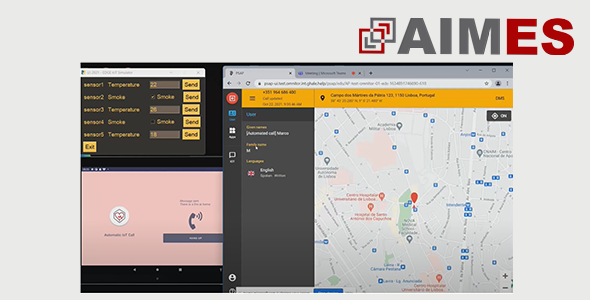AIMES Develops AIMES IoT-enabled Automated Emergency Calls System
July 2021

Within the AIMES project, EDGE is developing the IoT-enabled automated emergency call capability that, using EDGE’s IoT Middleware and the eCare IoT Hub, allows the simulation of smart devices and generates the IoT-enabled automated alerts and emergency calls, especially relevant in cases where individuals are unaware of the emergency or are not capable of initiating an emergency call.
EDGE’s IoT Middleware and the eCare IoT Hub are the comprising modules of the eCare Platform responsible for triggering the IoT-enabled automated alerts and emergency calls. Connected IoT smart devices, including medical and health devices (e.g., blood pressure monitors, glucometers, pulse oximeters, fitness trackers, body composition scales) and smart home sensors (e.g., smoke detectors, air quality sensors, motion sensors) have the capability to measure specific (health and wellbeing) parameters of interest or quantities of substances and transmit those data.
The eCare Platform gathers a wide range of measurements acquired through smart IoT sensors and devices that are seamlessly embedded in the living environment or are worn or interacted with by the individual. Amongst the measurements registered in eCare’s intelligence ambient platform are vital signs, physical measurements, health data and lifestyle and wellbeing data. In addition to wellbeing-related data, eCare delivers ambient living data (house temperature and humidity, air quality, motion) and facilitates the integration of environmental data including pollution, dust and pollen levels, especially relevant for individuals suffering from asthma and chronic obstructive pulmonary disease.
Upon the individuals’ explicit consent, the data may be shared with informal caregivers or healthcare professionals (care team) responsible for accompanying the individuals, allowing the care team to remotely access the (self)reported health and wellbeing parameters, follow the evolution of the individuals’ or patients’ condition and act promptly if needed (e.g., adjustment of medication, change of treatment, immediate phone contact).
Importantly, eCare includes the intelligence to identify the criticality of measurements received and to trigger automated alerts, displayed as warnings to the individuals and fed into the eCare remote monitoring platform installed at the point of care to alert the care team.
Based on the work conducted in the European project AIMES, the eCare Platform has now the new automated emergency call capability: upon the detection of a critical value (of smoke at home or of a vital signs’ reading), eCare displays an automated alert to the individual and, if there is reaction from the individual in a pre-defined amount of time, the system automatically generates a next generation emergency call. These calls are enriched with the smart IoT device’s information, the user’s information and emergency-related information, thus facilitating the understanding of the emergency by the emergency response team. This new built-in capability of eCare is considered relevant by both individuals and care professionals that consider it a fail-safe option whenever emergency assistance is required and lives are at risk.


